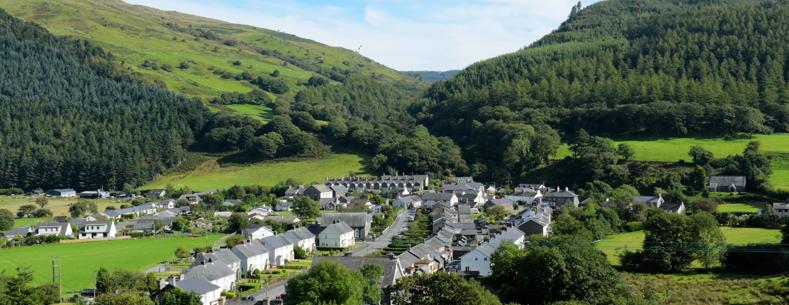Cost of living pressures are hitting households across Wales, with rising prices affecting many people, particularly those living in rural communities.
People in rural areas often experience higher daily costs than those in non-rural areas. This article outlines what’s contributing to these additional costs and how the Senedd and the Welsh Government are responding to them.
Rising energy prices
The rising cost of energy is one of the main things adding to current cost of living pressures. People in rural communities are particularly affected by this as they often face additional energy costs.
In 2020, 19% of domestic properties in Wales weren’t connected to the gas grid. Figure 1 shows that the highest percentage of off-grid households are across mid and west Wales, where there are many rural communities. Almost 75% of properties in Ceredigion are not connected to the grid, with over half of all properties in Powys and Anglesey being off-grid.
Figure 1: Estimated number and proportion of properties off the gas grid in Wales, by local authority (2020)
Source: UK Government, sub-national estimates of properties not connected to the gas network. Values refer to the estimated number of domestic properties without a gas meter, rounded to the nearest 10.
Rural households often rely on fuels such as oil or Liquified Petroleum Gas (LPG). Audit Wales’ 2019 fuel poverty report found that almost a third of rural households in Wales use oil as their main fuel for heating. Oil and LPG are more expensive than networked energy sources such as gas and electricity, and aren’t covered by Ofgem’s price cap. Between May 2020 and May 2022, the average price of heating oil in the UK increased almost 250% from £299.63 to £1046 per 1000 litres.
High energy costs are likely to be made worse by the very nature of rural housing, which is often older, not as well insulated, and less energy efficient than urban housing.
The Welsh Government’s Warm Homes Programme, which includes the Nest scheme, provides funding to low income households for energy efficiency improvements, with higher financial caps available to retrofit housing in rural off-grid areas.
Earlier this year, the Senedd’s Equality and Social Justice Committee carried out an inquiry into fuel poverty and the Warm Homes Programme.
The Committee’s report recommends that the Welsh Government create an energy efficiency scheme to tackle rural fuel poverty, including ways of addressing some of the specific challenges experienced in rural areas. The Welsh Government has yet to respond to the Committee’s recommendations.
What’s being done to support rural households with rising energy costs?
The Welsh Government has allocated additional funding to the Winter Fuel Support Scheme for 2022-23. The Social Justice Minister, Jane Hutt MS, said the Welsh Government is looking at ways to “widen the scheme to ensure more people receive the £200 payment”.
Off-grid households can get further support through the Discretionary Assistance Fund, with £250 offered to households using oil and three £70 payments for LPG. National Energy Action Cymru is concerned that the value of these payments doesn’t meet current need due to the rising cost of these fuels.
In June, the Minister launched a £4 million fuel voucher scheme to help pre-payment meter users and households living off-grid. The scheme includes a ‘Heat Fund’, which will provide direct support to help an estimated 2,000 eligible households who rely on heating oil and liquid gas.
The cost of essential items
When it comes to household spending, people in rural areas typically spend more on food and other essentials than those in urban areas. The Bevan Foundation highlighted that the “average rural household at GB level spends £641.10 per week on essentials compared with £572.90 for the average urban household”.
Rural households in Wales often experience less choice when buying essential items, as goods in local shops can be more expensive and ‘cheaper’ supermarkets are often less accessible, with higher transport costs to reach them. Inflation is likely to compound these additional costs, with the British Retail Consortium reporting that the rate of inflation for food in June 2022 was 5.6%.
Rising cost of agricultural inputs
Rising costs are also affecting farm businesses. The Andersons Centre estimated that UK Agflation (inflation linked to rising agricultural costs and prices) in June stood at 25.3%. The items facing the biggest price increases are fuel, fertiliser, and animal feed.
NFU Cymru is concerned that additional costs of production are likely to have an impact on farming incomes, as it’s difficult to pass these higher costs through the supply chain. Some farmers are looking to reduce production to make up for the rising costs.
The Farmers’ Union of Wales recently wrote to the Chair of the Senedd’s Economy, Trade and Rural Affairs (ETRA) Committee, highlighting the European Commission’s emergency measure to alleviate the impacts of the war in Ukraine on EU agriculture and food production. Announced in May, this allows the European Agricultural Fund for Rural Development (EAFRD) to be used to assist farmers and other businesses “affected by significant increases in input costs”.
While Wales doesn’t have access to that funding, the Minister for Rural Affairs and North Wales, and Trefnydd, Lesley Griffiths MS, told the ETRA Committee in June that retaining the Basic Payment Scheme (direct payments to farmers) to the end of 2023 is providing “much needed” stability for Welsh farmers.
Transport in rural areas
Public Policy Institute for Wales says that public transport in rural areas is “infrequent, inadequate and more expensive than elsewhere”. The limited availability of public transport can therefore lead to greater use of private vehicles in rural areas to access employment, education, essential shops, as well as social and leisure opportunities.
At the beginning of July the average price for a litre of petrol in the UK was just over £1.91, while the average cost for a litre of diesel was £1.99. The same time a year ago, prices were around £1.32 and £1.34 respectively. This increase is likely to bring additional costs to rural households as the price of fuel in rural and remote areas tends to be higher than non-rural areas.
A recent report by Sustrans Cymru emphasised that people living in rural areas of Wales are some of the worst affected by transport poverty. This is where a household would need to spend more than 10% of its income on the costs of running a car, whether the household has a car or not.
Options to lower transport costs, such as remote working or using an electric vehicle, are more limited in rural areas. There are constraints from the wider supporting infrastructures, including broadband and the availability of electric vehicle charging points.
In March, the Committee for the Scrutiny of the First Minister asked what the Welsh Government is doing to support rural households with rising public transport fares. The First Minister said it’s “a very challenging area” and that transport has required “extraordinary” government subsidy due to the pandemic.
What’s next?
The ETRA Committee recently held an inquiry on the economic and rural impact of cost of living pressures. The Committee is currently drafting its report, which will make recommendations to the Welsh Government.
In a recent Scrutiny of the First Minister session aimed at how the Welsh Government can support rural and coastal communities, the First Minister was asked how the Welsh Government is tackling transport poverty. Measures highlighted include trialling “demand responsive travel” and “innovative” hire systems. The First Minister also drew attention to the upcoming Bus Bill and regional transport plans, both expected to be introduced next year.
Article by Isobel Pagendam, Senedd Research, Welsh Parliament






